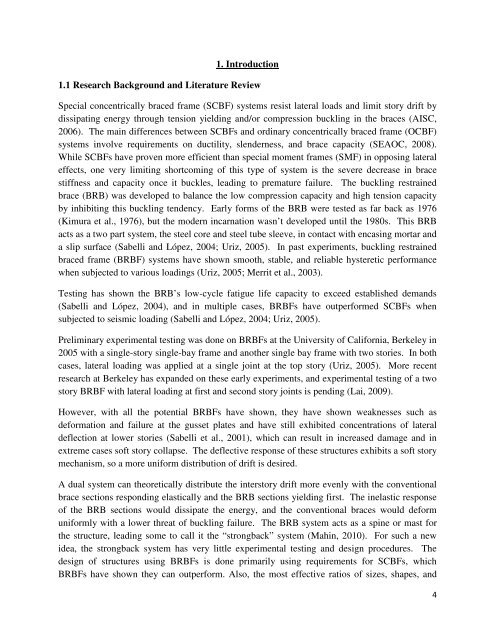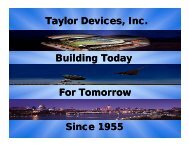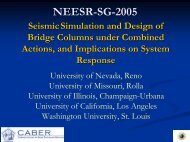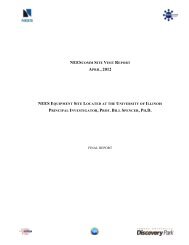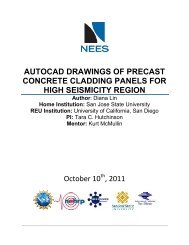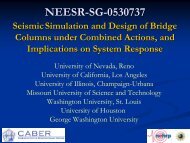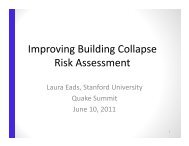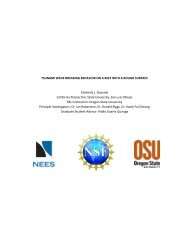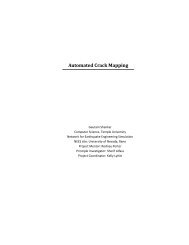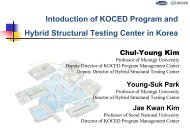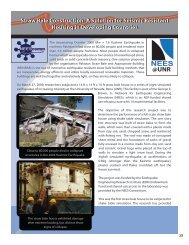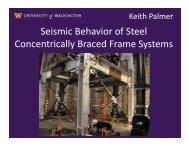PRELIMINARY STUDY OF THE STRONGBACK SYSTEM - PEER ...
PRELIMINARY STUDY OF THE STRONGBACK SYSTEM - PEER ...
PRELIMINARY STUDY OF THE STRONGBACK SYSTEM - PEER ...
You also want an ePaper? Increase the reach of your titles
YUMPU automatically turns print PDFs into web optimized ePapers that Google loves.
1. Introduction<br />
1.1 Research Background and Literature Review<br />
Special concentrically braced frame (SCBF) systems resist lateral loads and limit story drift by<br />
dissipating energy through tension yielding and/or compression buckling in the braces (AISC,<br />
2006). The main differences between SCBFs and ordinary concentrically braced frame (OCBF)<br />
systems involve requirements on ductility, slenderness, and brace capacity (SEAOC, 2008).<br />
While SCBFs have proven more efficient than special moment frames (SMF) in opposing lateral<br />
effects, one very limiting shortcoming of this type of system is the severe decrease in brace<br />
stiffness and capacity once it buckles, leading to premature failure. The buckling restrained<br />
brace (BRB) was developed to balance the low compression capacity and high tension capacity<br />
by inhibiting this buckling tendency. Early forms of the BRB were tested as far back as 1976<br />
(Kimura et al., 1976), but the modern incarnation wasn’t developed until the 1980s. This BRB<br />
acts as a two part system, the steel core and steel tube sleeve, in contact with encasing mortar and<br />
a slip surface (Sabelli and López, 2004; Uriz, 2005). In past experiments, buckling restrained<br />
braced frame (BRBF) systems have shown smooth, stable, and reliable hysteretic performance<br />
when subjected to various loadings (Uriz, 2005; Merrit et al., 2003).<br />
Testing has shown the BRB’s low-cycle fatigue life capacity to exceed established demands<br />
(Sabelli and López, 2004), and in multiple cases, BRBFs have outperformed SCBFs when<br />
subjected to seismic loading (Sabelli and López, 2004; Uriz, 2005).<br />
Preliminary experimental testing was done on BRBFs at the University of California, Berkeley in<br />
2005 with a single-story single-bay frame and another single bay frame with two stories. In both<br />
cases, lateral loading was applied at a single joint at the top story (Uriz, 2005). More recent<br />
research at Berkeley has expanded on these early experiments, and experimental testing of a two<br />
story BRBF with lateral loading at first and second story joints is pending (Lai, 2009).<br />
However, with all the potential BRBFs have shown, they have shown weaknesses such as<br />
deformation and failure at the gusset plates and have still exhibited concentrations of lateral<br />
deflection at lower stories (Sabelli et al., 2001), which can result in increased damage and in<br />
extreme cases soft story collapse. The deflective response of these structures exhibits a soft story<br />
mechanism, so a more uniform distribution of drift is desired.<br />
A dual system can theoretically distribute the interstory drift more evenly with the conventional<br />
brace sections responding elastically and the BRB sections yielding first. The inelastic response<br />
of the BRB sections would dissipate the energy, and the conventional braces would deform<br />
uniformly with a lower threat of buckling failure. The BRB system acts as a spine or mast for<br />
the structure, leading some to call it the “strongback” system (Mahin, 2010). For such a new<br />
idea, the strongback system has very little experimental testing and design procedures. The<br />
design of structures using BRBFs is done primarily using requirements for SCBFs, which<br />
BRBFs have shown they can outperform. Also, the most effective ratios of sizes, shapes, and<br />
4


